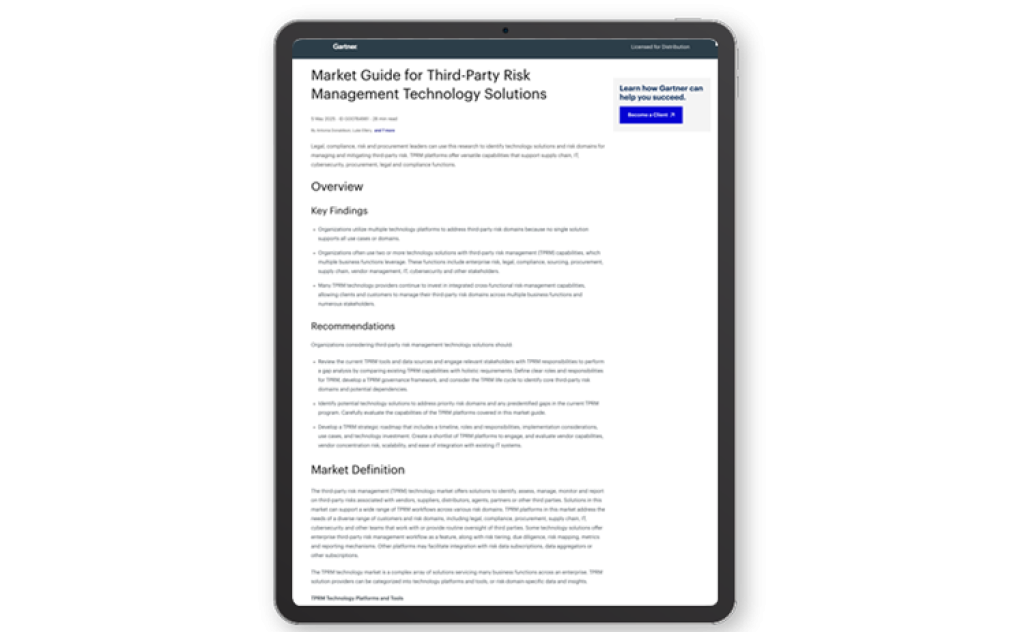The next-gen TPRM platform isn’t just a checklist engine. It’s AI-ready, lifecycle-aware, and GRC-integrated. Learn what matters in your next vendor eval and how today’s leaders are prepping for tomorrow’s risk.
Vendor Risk Management Principles: A Strategic Guide For Security Managers
Tags:

In today’s interconnected business environment, organizations rely heavily on third parties, and while third party relations are critical for success in most businesses, they also leave data more vulnerable to exposure from bad actors. This makes vendor risk management (VRM) a critical component of any company's overall risk management strategies. Effective VRM practices help protect sensitive data and maintain robust security postures, minimizing the potential risks introduced by vendors.
Why Is Vendor Risk Management Important?
Vendor risk management is essential in the current landscape where businesses are increasingly interdependent. The complexity of third-party relationships and the sensitivity of shared data necessitate stringent VRM protocols. Cybersecurity threats are evolving, and vendors can often be the weakest link in an organization’s security chain. Therefore, understanding VRM principles and identifying, assessing, and mitigating vendor-related risks are crucial to maintaining a secure operational environment.
Vendor Risk Management Principles for Security Managers
1. Identify Critical Data
Focus your VRM efforts on vendors managing your most critical data. Which vendors are handling the most valuable data in your organization? Which vendors host a critical service for you that isn’t protected or regulated well? Not all vendors pose the same level of risk, and prioritizing those handling sensitive information ensures that your most valuable assets are protected.
2. Verify Security Posture
Ensure that vendors’ security measures are as strong as or stronger than your own. Most organizations begin their vendor evaluation processes by reviewing compliance reports from governing bodies like ISO, NIST, or SOC2. These reports give you a glimpse into the vendor’s current cybersecurity posture, but are often subjective, unverifiable, and unactionable. Instead, using publicly observable metrics, through security assessments and audits of vendors’ practices, allow first party organizations to quickly and easily review their vendors without having to request anything from the third party. Collaborating with vendors to improve their security posture benefits both parties.
3. Holistic Vendor Review
Collaborate across departments and internal groups to evaluate vendors comprehensively. VRM is not solely the responsibility of the IT or security department; it requires input from legal, finance, human resources, and other relevant departments. This multidisciplinary approach ensures a thorough evaluation of vendors’ risks and mitigations.
4. Continuous Monitoring
Regularly monitor vendors to detect and address security issues promptly. Vendor risk management is an evaluation of a continual relationship, not an evaluation of a specific point in time. Continuous monitoring tools can provide real-time insights into vendors’ security status, enabling proactive risk management. This includes monitoring for vulnerabilities, compliance with security policies, and any changes in vendors’ security posture.
5. Develop a Response Plan
Have a well-defined response plan for vendor-related incidents. Despite best efforts, incidents can still occur, and having a response plan ensures that your organization can react quickly and effectively. This plan should include communication protocols, roles and responsibilities, and steps for containment and remediation.
6. Foster Strong Vendor Relationships
Building strong relationships with your vendors can enhance collaboration on security matters. Regular communication and collaboration can help vendors understand your security expectations and improve their practices accordingly. Trust and transparency are key to successful VRM.
7. Leverage Technology
Utilize advanced technologies to streamline VRM processes. Tools like security ratings platforms, automated assessment tools, and continuous monitoring solutions can enhance your VRM efforts. These technologies provide valuable insights and help manage vendor risks more efficiently.
What Increases Vendor Risk? 6 Scenarios
1. Lack of Cybersecurity Communication
Many organizations fail to communicate the importance of cybersecurity to their vendors from the outset. This can lead to a misalignment of security priorities and practices. Consider how you’d discuss other aspects of a business deal, like the scope of the business relationship, the financial terms, and the time frame. Treat cybersecurity with the same importance. Establishing clear communication channels and expectations regarding cybersecurity is fundamental to effective VRM.
2. Unspecified Data Access
It is critical to know who within a vendor’s organization has access to your sensitive data and where this data is physically stored. Unspecified data access can lead to unauthorized access and potential data breaches. Implementing stringent access controls and regularly auditing access logs can mitigate this risk.
3. Non-specific Contracts
Contracts with third parties often lack specific cybersecurity requirements. Clearly outlining these requirements in contracts ensures that vendors understand and adhere to your security standards. This includes specifying security measures, compliance requirements, and incident response protocols.
4. Inadequate Audit Review
Regularly reviewing and verifying vendors’ audit reports is essential. Many organizations overlook this step, leading to gaps in their security posture. In this day and age, including the mantra “trust but verify” is necessary in your risk management principles. Security ratings reports provide insights into a vendor’s security practices and help identify potential vulnerabilities. This should allow you to glean what the company has been doing for several years prior, which should help you determine whether a business relationship is worth pursuing.
5. Third-Party Management Awareness
Understanding how vendors manage their own third-party relationships is crucial. Vendors often rely on their own third parties, introducing additional layers of risk. Ensuring that your digital supply chain robust third-party management practices in place is essential to mitigating these risks.
6. Over-reliance on Annual Assessments
Relying solely on annual assessments is insufficient in today’s fast-paced threat landscape. An organization’s security posture can change every hour of every day. Continuous monitoring of vendors is necessary to detect and address security issues promptly. This involves real-time monitoring tools and regular security assessments.
Limitations of Vendor Risk Assessment Templates
Subjectivity
Nearly every vendor has completed a cyber risk assessment template. Vendor risk assessment templates can be subjective and may not accurately reflect the specific needs and risks of your organization. Each organization has unique risk profiles, and generic templates might overlook critical aspects of these profiles.
Lack of Verifiability
It is challenging to verify the accuracy of vendors’ responses in assessment templates. Vendors might not always provide truthful or comprehensive answers, leading to a false sense of security. Independent verification of vendors’ security practices is necessary.
Inaction
Templates alone do not provide actionable insights. While they can help identify potential risks, they often fall short in offering concrete steps for mitigation. The real work begins when your vendor completes the template and returns it to you. Organizations need to develop action plans based on the findings from these assessments.
Implementing Effective VRM Programs
Assessment and Onboarding
Begin with a thorough assessment of potential vendors during the onboarding process. This includes evaluating their security posture, compliance with industry standards, and overall risk profile. Establishing clear criteria for vendor selection ensures that only vendors meeting your security requirements are onboarded.
Contractual Agreements
Develop comprehensive contracts that outline security requirements and expectations. Contracts should include clauses related to data protection, compliance, incident response, and audit rights. Regularly reviewing and updating these contracts ensures that they remain relevant and effective.
Regular Assessments
Conduct regular assessments of vendors’ security practices. This includes periodic audits, security questionnaires, and on-site inspections. Regular assessments help identify new risks and ensure that vendors maintain their security posture.
Incident Management
Develop and implement a robust incident management process for vendor-related incidents. This process should include steps for detection, reporting, containment, and remediation of incidents. Regularly testing and updating this process ensures that your organization is prepared for any eventuality.
Training and Awareness
Provide training and awareness programs for vendors on cybersecurity best practices. Educating vendors about potential threats and how to mitigate them can enhance their security posture. Regular training sessions and awareness campaigns help reinforce the importance of cybersecurity.
Performance Metrics
Establish performance metrics to evaluate the effectiveness of your VRM program. Metrics such as the number of incidents, time to resolve issues, and compliance rates provide insights into the program’s success. Regularly reviewing these metrics helps identify areas for improvement.
In Summary
Vendor risk management must be a priority for all security managers. By implementing effective VRM practices, organizations can protect their sensitive data and maintain robust security postures. However, traditional VRM tactics aren’t enough to keep your data safe. That’s why we created this free ebook on creating efficiencies in VRM. Download it today to learn how vendor risk management is typically handled, what makes those strategies inadequate, and how you can more effectively mitigate cyber risk in your organization.



